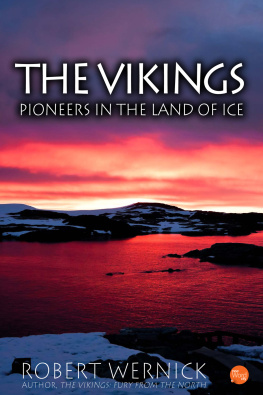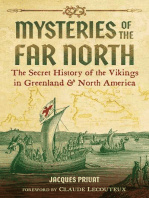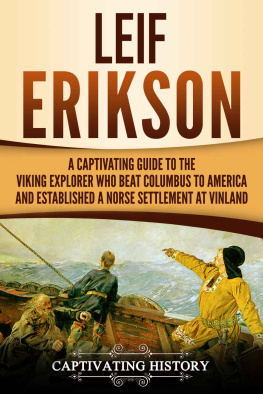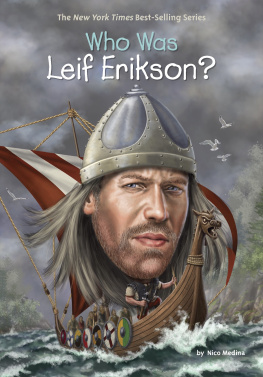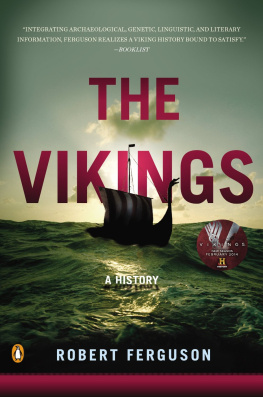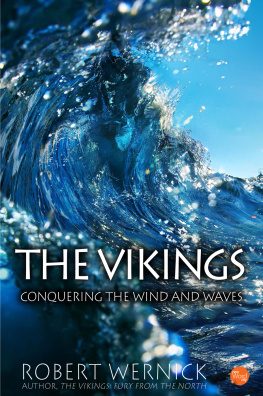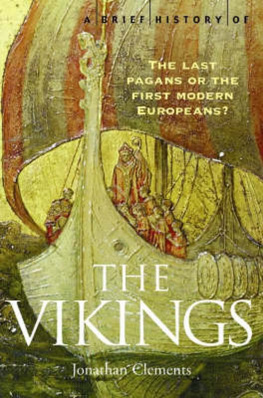Eirik Thorvaldsson Raudi - Eirik the Red - was red of hair and red of beard, bloody of heart and bloody of hand. He was a murderously bad neighbor, a scoundrel on a grand scale, a heathen to the core, and to the last of his life he remained unregenerate. Yet, he was a towering figure of a Viking. And others would follow him to the end of the world and live with him at the end of human existence.
Cast out by his own society and driven by the forces of his own nature, Eirik thrust boldly toward the western horizon, where, on the perilous rim of Greenlands great permanent ice cap, he founded a settlement that would survive for nearly five centuries as a monument to human endurance. Eiriks son Leif was less of an outcast. Yet within him stirred the same burning desire to reach westward beyond the wilderness of the ocean - and that hungering took him to the apogee of Norse explorations: America, which Christopher Columbus was not to encounter for another half millennium.
Thus, step by step - from Norway to the Faroes to Iceland, Greenland, and finally to America - the Vikings traversed the formidable North Atlantic, a perilous distance of more than 3,000 miles from the fjords of Norway, entrusting their lives to their own seamanship and their doughty little vessels. The sagas accounts of the Norse adventure in America - or, as Leif named it, Vinland - are obscure, fragmentary, and often exaggerated. Precisely where the Vikings went, how long they stayed, what they did, and why they left are pieces of a tantalizing puzzle. Equally baffling is the sudden and still unexplained disappearance of the Norsemen from the Greenland settlements they had clung so tenaciously to for so long. Yet whatever the immediate (and perhaps inconsequential) details, the Norse withdrawal from Vinland and then from Greenland was part of the wormwood process of decay that brought an end to the great age of the Vikings.
Just as the Viking colonists faded into the mists of the sagas, so the Viking warriors, those valiant, wrathful, purely pagan people of the early Irish lament, gradually found themselves tamed and assimilated by the very peoples they had conquered in both east and west. Viking traders, too, saw themselves superseded by more powerful and sophisticated rivals. And though no one ever sailed more beautiful ships, the master builders of other lands constructed crafts that were so much larger and more useful that the Viking knarr and longship passed from the seas.
Eirik the Red was a sign and symbol of the famed Viking age and of its demise. He was born around 950 on a farm in southwest Norway. His violent nature found an early outlet. While Eirik was in his late teens, he and his father Thorvald plunged - joyously, in all certainty - into one of the innumerable and interminable blood feuds that so fortified yet depleted Viking manhood. In the offhand words of a saga, there were some killings. Eirik and Thorvald were outlawed, and, like so many outlaws before them, they followed their fate to Iceland.
They arrived late. By then, in the 960s, all of Icelands good land had been taken, and what was left for recent outcasts was a rocky, hardscrabble tract on the cruel northwestern coast. Thorvald soon died, and Eirik was left to fend for himself - which he set about to do with a vengeance. He married Thjodhild, daughter of a prosperous family and, as it turned out, one of the few persons on earth whose willfulness matched Eiriks.
Eirik moved south and - probably with the help of his in-laws and perhaps by force - took and cleared land at Haukadal, an area of grass and birch woods on an arm of the Breidafjord. But Eirik was never much for peaceful coexistence. Violence was always surging in his soul, and soon another feud resulted in the bloody deaths of two of his neighbors. Again Eirik was forced to flee. He dismantled his house, timber being too valuable in wood-scarce Iceland to leave behind, and moved on Oxney, on a Breidafjord promontory about fifty miles west of Haukadal.
Shortly after he arrived, in a rare moment of neighborliness, he loaned some of his house beams to a man named Thorgest, who wanted them briefly for his farmstead. But soon came the inevitable day when Eirik decided where to settle. He began to put up his own house and demanded the return of his beams. Thorgest refused, thereby setting off yet another terrible feud. This one embroiled the entire countryside and brought violent death to two of Thorgests sons. The vicious quarrel finally was resolved at the local assembly. Though his cause, for once, was just, Eirik and his supporters were voted down by Thorgests allies, and Eirik the Red was sentenced to three years banishment from Iceland.
According to custom, he was given a few days to pack up his belongings, and he used his time well. Thanks mostly to the affluence of his wifes family, he bought and provisioned a knarr, then set about collecting desperate men to accompany him on a desperate adventure. They were not hard to find. A few years before, Iceland has suffered a famine in which, according to a chronicler, men ate ravens and foxes, and many loathsome things were eaten that should not be eaten, and some men had the old and helpless killed and thrown over the cliffs. The famine passed, but it left destitute many families, mostly the owners of marginal lands, whose strong sons and husbands were not eager to seek new fortune in a new land.
Eirik knew - more or less - where he wanted to go. More than fifty years before, sometime between 900 and 930, one Gunnbjorn Ulf-Krakason had been scooped up by a tremendous gale while he was sailing down from Norway to Iceland, had missed his destination, and had been storm-tossed far to the west. Eventually he sighted a cluster of tiny rock islands, and he spied in the dim distance beyond them the looming, shadowed form of an immense land mass. But the place was not in the least inviting to Gunnbjorn. After naming the islets Gunnbjarnarsker, after himself, he put them in his wake the moment the wind turned fair, returning to his home in the same Breidafjord pocket of Iceland where, long after Gunnbjorns death, Eirik the Red found his final Icelandic refuge.
Icelandic mariners had talked and speculated often about Gunnbjorns islands, and at least one attempt had been made to explore this new corner of the earth. A man named Snaebjorn, seeking to escape retribution for murder, had sailed in that direction with a number of companions in two boats. He found a little shelf of land at the edge of the monstrous icecap of Greenland, and there he built a dwelling. The arctic winter came howling down on the settlers, burying their house so deep in snow that they had to dig a tunnel upward to get out to the surface, so they could make their way down to their boats. They caught enough fish to keep them from starving. But, cooped up in the fetid darkness, they allowed old rivalries and grievances to awake. Before they could get away in the spring, three men, including Snaebjorn, had been killed.
Eirik, of course, had heard the tale of Gunnbjorns errant voyage, and of Snaebjorns. The huge, mysterious mass sighted by Gunnbjorn could only have been the answer to Eiriks pagan prayers. In 982, at about thirty-two years of age, Eirik Thorvaldsson Raudi set forth.
The way was not particularly long, some 450 miles, and easy enough with favorable winds. Eirik sailed from under the Snaefellsnes, a glacial promontory that, like a giant index finger, points due west from Icelands western coast. Moving steadily before the prevailing easterly breezes of early summer, Eirik tracked carefully along the sixty-fifth parallel, sighting the sun by day and Polaris by night. What Eirik and his crew beheld after four days or so of sailing was horrifying. Before them, blinding in their brilliance beneath the sun, were cliffs that fell sheer from a monster icecap. As they approached, the Vikings could see the tips of enormous mountains peeking above the ice. The bravest men might have been excused for turning back. But Eirik the Red coasted south. He may have headed out to sea and rounded Cape Farewell at the southeastern extremity of the new land. More likely, knowing that if grazing land existed it would be found along the banks of the fjords, Eirik turned off, probing and feeling his way for mile after forbidding mile through a labyrinth of narrow, intersecting waterways until, at last, he made his exit on the western coast.
Next page





